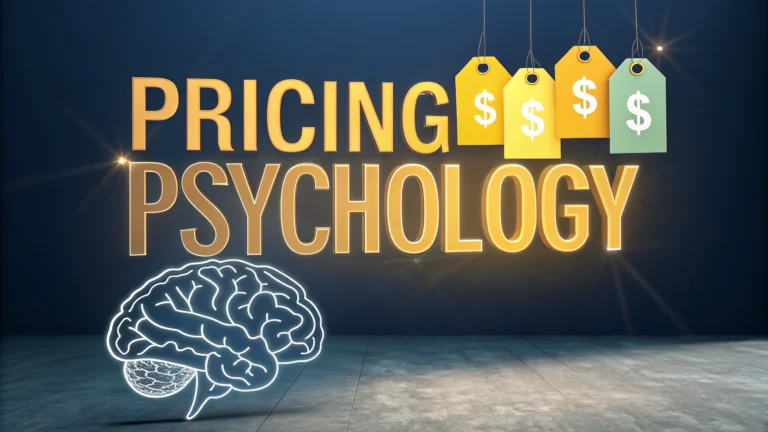The right price point can make or break a logo design project’s success, and understanding pricing psychology helps designers set rates that clients perceive as fair while maintaining profitability.
Basic Pricing Strategies for Logo Design
Most successful logo designers use one of these proven pricing approaches:
- Value-based pricing: Setting rates based on the client’s perceived value and ROI
- Time-based pricing: Charging an hourly rate (typically $50-250/hour for logo design)
- Package pricing: Offering pre-set bundles with different deliverables
- Project-based pricing: Quoting a flat fee based on project requirements
Price Anchoring Techniques
Price anchoring helps clients understand the value of your logo design services by providing strategic reference points.
- Present your preferred package between lower and higher-priced options
- Show the original price crossed out next to the current price
- Compare your rates to the cost of DIY or template solutions
- Highlight the long-term value versus one-time cost
Sample Logo Design Package Structure
| Basic ($500) | Professional ($1000) | Premium ($2000) |
|---|---|---|
| 2 concepts | 4 concepts | 6 concepts |
| 2 revisions | 3 revisions | Unlimited revisions |
| Basic files | All file formats | All files + style guide |
Psychological Pricing Tips
- Use charm pricing (ending in 9, 95, or 97) for lower-end packages
- Round numbers work better for premium services ($2000 vs $1999)
- Break down large amounts into smaller daily costs
- Offer payment plans for higher-priced packages
Common Pricing Mistakes to Avoid
- Setting prices too low to compete with marketplace sites
- Not factoring in research and consultation time
- Failing to communicate value through pricing presentation
- Neglecting to adjust rates based on market changes
Contact professional design organizations like AIGA (www.aiga.org) for current industry pricing standards and guidelines.
Price Communication Strategies
- Present prices after establishing value through portfolio examples
- Include case studies showing ROI for previous clients
- Clearly outline deliverables and timeline for each price point
- Offer a satisfaction guarantee to reduce perceived risk
Remember to regularly review and adjust your pricing strategy based on market conditions, your skill level, and client feedback.
Negotiation Best Practices
- Always start with your standard rates before offering discounts
- Bundle additional services instead of lowering prices
- Offer rush fees for expedited timelines
- Create volume discounts for multiple logo variations
Value-Add Components
Additional Services to Include
- Brand guidelines documentation
- Social media kit
- Business card design
- Favicon and app icons
Market Positioning
- Research competitor pricing in your target market
- Define your unique value proposition
- Position pricing based on expertise level
- Adjust rates for different industry sectors
Client Education
- Explain the design process and timeline
- Share resources about logo importance
- Provide case studies of successful projects
- Document the deliverables in detail
Conclusion
Effective logo design pricing requires balancing market demands with profitability while clearly communicating value to clients. Regular evaluation of pricing strategies, staying current with industry standards, and maintaining transparent communication with clients ensures long-term success in the logo design business.
Implement these pricing strategies gradually, monitor results, and adjust based on client feedback and market response. Remember that your pricing structure should evolve as your skills and reputation grow in the industry.
FAQs
1. What is pricing psychology in logo design and why is it important?
Pricing psychology in logo design involves strategic price positioning that influences perceived value and client decision-making. It’s crucial because it affects how potential clients view your expertise, quality, and professional standing in the design industry.
2. Should I use odd or even numbers when pricing logo design services?
Odd numbers, particularly those ending in 9 or 7, tend to be more effective in logo design pricing. For example, pricing at $499 rather than $500 creates a psychological perception of a better deal while maintaining professional value.
3. How does anchoring affect logo design pricing?
Anchoring is when you present a higher-priced option first, making subsequent prices seem more reasonable. For logo design, showing a premium package at $2,000 first can make a standard package at $800 appear more attractive to clients.
4. What’s the decoy effect in logo design pricing packages?
The decoy effect involves offering three pricing tiers where the middle option is strategically priced to make the highest tier more attractive. This pricing strategy helps clients gravitate toward higher-value logo design packages.
5. How does price bundling work in logo design services?
Price bundling combines multiple design elements (logo variations, business cards, brand guidelines) into packages, creating perceived higher value. This strategy typically results in higher overall sales than selling items separately.
6. What role does charm pricing play in logo design quotes?
Charm pricing uses psychological price points (like $995 instead of $1,000) to create the illusion of significantly lower prices. This technique works effectively in logo design when balanced with maintaining professional credibility.
7. How should seasonal pricing be applied to logo design services?
Seasonal pricing involves adjusting rates during peak business periods (fiscal year-end, business launch seasons) or offering special promotions during slower periods to maintain steady workflow.
8. What is premium pricing psychology in logo design?
Premium pricing positions logo design services at a higher price point to suggest superior quality and expertise. This strategy works particularly well for established designers targeting luxury brands or corporate clients.
9. How does the paradox of choice affect logo design pricing?
Offering too many pricing options can overwhelm clients and reduce conversions. The optimal approach is presenting three clear pricing tiers for logo design services, making decision-making easier for clients.
10. What is price anchoring through comparison in logo design?
Price anchoring through comparison involves displaying your prices alongside competitor prices or industry averages to demonstrate value. This helps clients understand market positioning and justifies your rates in the context of the broader market.







